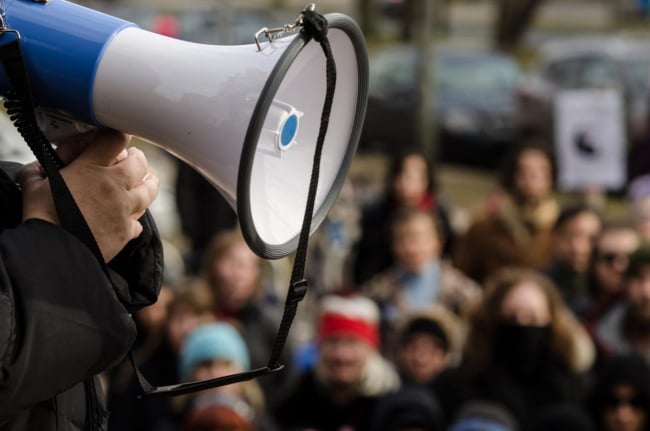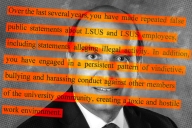You have /5 articles left.
Sign up for a free account or log in.

shaunl/istock.com
Student protests are nothing new. Neither are union protests, for that matter, or community actions.
What is new are the tactics those groups are employing during the coronavirus pandemic, a crisis that has laid bare class divisions and economic frailty, with the potential to push many into poverty. Because of public health guidelines that prevent gathering or even meeting other people in person, the protests and rallies of a few months ago are now unthinkable. Groups with something to say are discovering new tactics while finding new energy and engagement.
Car caravans, online think tanks and broad intercampus coalitions are just some of the new hallmarks of the post-outbreak protest movement.
New Energy
"COVID-19 really showed what really happens when all of these inequities that higher education has been forgetting about just get laid bare," said Grace Wickerson, outgoing student body president at Rice University.
Wickerson, along with incoming president Anna Margaret Clyburn, have both been involved in a coalition of over 150 student body presidents, representing more than two million students. The coalition has written two open letters: one asking graduate schools and other institutions to generously accept pass/fail grades received during this time for transfer credit and prerequisites, and another asking state medical licensing boards for mental health to expand telehealth access across state lines.
Though there have been efforts in the past to get the student presidents to unite, it a took a pandemic for that movement to come to fruition, Clyburn said.
"We’ve seen people get really engaged on campus," she said. "But I feel this was a level of engagement that was unusual or unique."
Though the pandemic affected people in different ways, it gave students something to unite around, Wickerson said.
"Because college campuses are becoming increasingly more diverse, there are pockets of activism because there are different student groups that are pushing for different things. And not everyone is talking to each other or trying to figure out how to work together," they said. “But when a pandemic strikes, everyone is affected under a same issue area that we see affecting all those populations. Yes, in different ways, but all under this uniting factor."
At other institutions, students have engaged in tuition strikes or elected not to attend class until their fees are discounted. Throughout March, petitions asking administrations to change grading schemes circled and, in an overwhelming number of places, were successful. Even earlier, students began mobilizing mutual aid networks to assist each other and their neighbors.
Clyburn said she understands that future activism on campus might be more difficult now. Change that requires financial input from the university could be harder to achieve, she said, as severe revenue loss threatens nearly every institution.
Wickerson said they hope the engagement continues.
"I hope this energy can be continued after this pandemic," they said. "We hope that this brings us together and we can continue to push for some of these things that, maybe without COVID-19 exacerbating them, they would not have been discussed."
New Tactics
As rallies have become a public health threat and in many states are banned, the humble "car caravan" has emerged as the new go-to technique to signal unrest. Protesters put signs on their cars, honk their horns and circle a route to draw attention to their cause.
Ben Luce, a physics professor at Northern Vermont University, in late April organized a caravan of over 100 cars to protest a proposal that would close three state college campuses in Vermont, including his own.
"This is a manufactured crisis," Luce said. "The state of Vermont has grossly underfunded the state college system for well over a decade."
Chancellor Jeb Spaulding told VTDigger that the pandemic exacerbated existing financial vulnerability in the state college system and threatened its existence. State funding for the colleges dropped to 17 percent in 2018, and the pool of Vermont high school graduates is shrinking.
"I did not buy in to the chancellor's rhetoric that we are facing a financial crisis due to drop in enrollment," Luce said. "The lack of state funding has made our tuition noncompetitive, it's crippled our ability to advertise, it's kept our programs from developing fully. It's no wonder that we've been having these problems, and I fully believe they are correctable quite easily with increasing the state funding."
After protesters honked their horns and called for him to be fired, Spaulding withdrew the proposal and resigned last Wednesday.
"The current configuration of the Vermont State Colleges is not sustainable," Spaulding said as part of his announcement to shelve the proposal. "It cannot continue for long."
On the car parade, Luce said it was more impressive than he anticipated.
"It was actually very exciting and very effective," he said. "I would organize one again even without the pandemic."
Staff and faculty unions at Rutgers University engaged in a similar caravan last week, asking the administration to provide health-care employees with more personal protective equipment and stop adjunct layoffs.
Far from deterring people from showing up, Luce said the pandemic may have increased turnout for his protest.
"There was an existential threat to people's jobs and people's communities," he said. "People are tense, pent up and they're sitting around at home with a lot of time on their hands for social media."
New Militancy
Graduate students in the University of California system are no strangers to protest action. The #COLA4All movement, which called for a cost-of-living adjustment for graduate students to help cover high rents near universities, started in late 2019 at UC Santa Cruz and spread to several other campuses. The action culminated in grading strikes and picket lines that blocked entrances to university campuses and forced administrations to cancel classes. At the height of tensions, nearly 80 Santa Cruz graduate students saw themselves fired from their teaching appointments for withholding grades.
Last week, grad students at UC Santa Barbara were the last to turn in any winter-quarter grades they had been withholding. But as many involved in the COLA movement have emphasized, their fight is not over.
With picket lines now unthinkable, one of the hallmarks of the movement's post-outbreak presence is Strike University, a self-styled online "think tank" for the UC COLA movement. At its most basic, Strike U is a website. But it's also a digital space for organizers to live out a vision of what a "people's university" might look like. Professors and grad students give free online lectures over Zoom, while organizers have a space to discuss what a democratized, decolonized and freely accessible university might look like, and what stands in its way.
Melanie Brazzell, one of the organizers behind the project who had the original idea for Strike U, said the idea was to try to imitate the energy of a picket line or other revolutionary spaces.
"In a [social movement] ecology, some people are holding down the corners on mobilizations and making demands of those who have power and taking power," said Brazzell, who studies and works with social movements. "But there's another corner of the social movement ecology that's about alternative institution-building and modeling the world we're trying to create."
Strike U holds down that corner, they said. It's about creating something by and for people who are marginalized or whose visions of the university have been excluded.
In addition to the free lectures and teach-ins, a series of courses called Wildcat Organizer School goes over the basics of organizing opposition and dissent against an institution like UC, part of building capacity and infrastructure for the long-term movement, Brazzell said. Some campuses have partnered with organizations in their neighborhoods to expand the mission of the COLA movement.
The Strike Syllabus project was formed to teach undergraduates about some of the underpinnings of the graduate opposition to the UC and give instructors materials to use in their classrooms. Recorded mini-lectures cover topics like the California tax code and how it relates to underfunding of education and the housing crisis in the state.
"Once we got the stay-at-home order from our chancellor, that really changed the dynamic of the strike," said Eugene Riordan Jr., a Strike Syllabus organizer from UCSB.
Riordan said he and co-organizer Thomas Franke might have had a similar idea had they still been on campus, but the digital platform has made the content more accessible.
"Our teach-in schedule while on campus was inaccessible for me, just because I would have meetings throughout the day, so I could often not go to the teach-ins," he said. "A digital platform has made things much easier to access."
Franke said that people who weren't as visible or vocal in picket lines and grading strikes have really engaged with Strike U and other online efforts and have been invigorated by them.
"It's been exciting to see the variety of engagement across digital platforms," he said.
It was natural for the movement to progress to an intercampus level, Brazzell said, and though it's flawed in many ways, the digital space has made that even more possible.
"We can bring people together on an intercampus level in a way that would have been difficult if people weren't all on their computers a lot right now," they said. "We can do more with Strike U when it's this digital space than we could if it were physical space."








